Best Data Entry Software
Best data entry software options include Covve, PhraseExpander, Forms On Fire, Jotform, Lucy, and UiPath. These solutions are a successful replacement for the manual paperwork and data entry processes that take place in organizations.



No Cost Personal Advisor
List of 20 Best Data Entry Software
Category Champions | 2024
AI driven web scraping & workflow automation platf
APISCRAPY is an AI-driven web scraping and automation platform that converts any web data into ready-to-use data API. The platform is capable to extract data from websites, process data, automate workflows, classify data, and integrate. Read APISCRAPY Reviews
Explore various APISCRAPY features, compare the pricing plans, and unlock the potential of seamless operations by selecting the right software for your business.
Features
View all APISCRAPY Features- Data Analysis
- Data Cleansing
- Pricing Extraction
- AI / Machine Learning
- Image Recognition
- Data Extraction
- Analytics
- Web Data Extraction
Pricing
APISCRAPY Caters to
- StartUps
- SMBs
- Agencies
- Enterprises
Contenders | 2024
Productivity and Collaboration Tools
Shivaami is an authorized Google Cloud Partner, that offers Google Workspace, formerly known as G Suite, a cloud-based productivity and collaboration suite developed by Google. It includes a variety of applications such as Gmail, Google Drive, Docs, Sheets, etc. Read Shivaami Reviews
Explore various Shivaami features, compare the pricing plans, and unlock the potential of seamless operations by selecting the right software for your business.
Features
View all Shivaami Features- Offline Access
- Real-time Scheduling
- Full Text Search
- Calendar Management
- Two-Way Messaging
- Screen Sharing
- Meeting Room Booking
- Cloud Access
Pricing
Business Starter
$ 72
User/Year
Business Standard
$ 144
User/Year
Business Plus
$ 216
User/Year
Shivaami Caters to
- StartUps
- SMBs
- Agencies
- Enterprises
Contenders | 2024
Data entry correction software for enterprises and freelancers
Use the built-in form builder system of the leading form automation software, Zoho Forms and collect the data in no time. With the mighty help of this best software to create forms, you can easily create the 3rd party online forms. Read Zoho Forms Reviews
Explore various Zoho Forms features, compare the pricing plans, and unlock the potential of seamless operations by selecting the right software for your business.
Features
View all Zoho Forms Features- Intake Forms
- Data Entry
- Offline Response Collection
- Highly Customizable Forms
- Form Design and Generation
- Online payments
- Forms Management
- Lead Capture
Pricing
Basic
$ 8
Per Month
Standard
$ 20
Per Month
Professional
$ 40
Per Month
Zoho Forms Caters to
- StartUps
- SMBs
- Agencies
- Enterprises
Contenders | 2024
Software by Typeform
Leverage the data collection process by implementing mighty aid of Typeform, the leading form automation software. You can easily create need-based forms, polls, and surveys with the help of this innovative online form software. Read Typeform Reviews
Explore various Typeform features, compare the pricing plans, and unlock the potential of seamless operations by selecting the right software for your business.
Pricing
Basic
$ 0
Per Month
Pro
$ 30
Per Month
Pro+
$ 59
Per Month
Typeform Caters to
- StartUps
- SMBs
- Agencies
- Enterprises
Contenders | 2024
Software by Phoenix Software International
Entrypoint is a complete application development package for creating high-performance data entry applications, with special features for clinical trials. Access Entrypoint i4 on the web or your local machine. Entrypoint uses SQL databases for data storage. Read Entrypoint Reviews
Explore various Entrypoint features, compare the pricing plans, and unlock the potential of seamless operations by selecting the right software for your business.
Features
View all Entrypoint Features- Data Verification
- Data Entry
- Data Capture and Transfer
- Data Search Flexibility
- Data Quality Control
Entrypoint Caters to
- StartUps
- SMBs
- Agencies
- Enterprises
Emergents | 2024
Workflow Automation Software for businesses
Streamline your business processes and automate the workflow between remote and office teams, and customers. Increase your team productivity by collecting field data on mobile devices and getting real-time insights. Learn more about Fluix
Explore various Fluix features, compare the pricing plans, and unlock the potential of seamless operations by selecting the right software for your business.
Features
View all Fluix Features- Mobile Access
- Audit Trail
- Work order management
- Access Controls/Permissions
- Incident Management
- Role-Based Permissions
- Rules-Based Workflow
- Electronic Signature
Pricing
Core
$ 30
User/Month
Fluix Caters to
- StartUps
- SMBs
- Agencies
- Enterprises
Contenders | 2024
Software by Airtable
Airtable is the solution for CRM to manage all-in-one with powerful features. It suits for such business like entertained, restaurant and hotels. It is very accurate and flexible software that delete all the duplication itself and integration with social media for secure communication. Read Airtable Reviews
Explore various Airtable features, compare the pricing plans, and unlock the potential of seamless operations by selecting the right software for your business.
Features
View all Airtable Features- Project Management
- CRM Analytics
- Lead Management
- Opportunity Management
- Dashboard
- Appointment Management
- Proposal Management
- Access Monitoring
Pricing
Free
$ 0
User/Month
Plus
$ 10
User/Month
Pro
$ 20
User/Month
Airtable Caters to
- StartUps
- SMBs
- Agencies
- Enterprises
Emergents | 2024
Software by ProntoForms Corporation
ProntoForms Pro offers an unmatched set of features and capabilities, including an unlimited number of forms and submissions, unlimited cloud and back-office integrations, off-line use, sophisticated dispatch & workflow features, best-in-class user experience, export to PDF/Word/HTML and more. Learn more about ProntoForms
Explore various ProntoForms features, compare the pricing plans, and unlock the potential of seamless operations by selecting the right software for your business.
Pricing
Pro
$ 25
User/Month
Enterprise
$ 35
User/Month
ProntoForms Caters to
- StartUps
- SMBs
- Agencies
- Enterprises
Contenders | 2024
One platform to power all your data
Generating leads and collecting data is now easy and effortless with the help of JotForms, one of the most trusted form automation software. The form software comes with user-friendly form builders that create online forms in no time. Read Jotform Enterprise Reviews
Explore various Jotform Enterprise features, compare the pricing plans, and unlock the potential of seamless operations by selecting the right software for your business.
Features
View all Jotform Enterprise Features- Drag & Drop
- Offline Response Collection
- Document Management
- K-12
- Audience Targeting
- Client Management
- Approval Process Control
- Annotations
Jotform Enterprise Caters to
- StartUps
- SMBs
- Agencies
- Enterprises
Contenders | 2024
Software by UiPath
UiPath is one the eminent RPA software that displays variety in features crafted for business and IT leading to AI. It reassures reasonable security with an enable AI and relies upon AI ecosystem. Equipped with robotic process automation tools, it is easy to use and manage large-scale automation. Read UiPath Reviews
Explore various UiPath features, compare the pricing plans, and unlock the potential of seamless operations by selecting the right software for your business.
Features
View all UiPath Features- Work Queue
- Architecture
- Performance Management
- Elastic Scalability
- Analytics
- Security & Governance
UiPath Caters to
- StartUps
- SMBs
- Agencies
- Enterprises
Emergents | 2024
Software by Nintex
Nintex is a fully featured Document Management Software designed to serve Startups, SMEs. Nintex provides end-to-end solutions designed for Windows. This online Document Management system offers Compliance Management, Automated Routing, Document Indexing, Electronic Signature, Full Text Search at one place. Learn more about Nintex
Explore various Nintex features, compare the pricing plans, and unlock the potential of seamless operations by selecting the right software for your business.
Features
View all Nintex Features- Interaction Tracking
- File Recovery
- Templates
- Offline Access
- Multiple Output Formats
- Text Editing
- Data Entry
- Archiving & Retention
Pricing
Standard Edition
$ 650
Per Month
Enterprise Edition
$ 950
Per Month
Nintex Caters to
- StartUps
- SMBs
- Agencies
- Enterprises
Emergents | 2024
Software by nTask
nTask is a fully featured Task Management Software designed to serve Startups, SMEs. nTask provides end-to-end solutions designed for Windows. This online Task Management system offers Collaboration Tools, Percent-Complete Tracking, Recurring Task Management, Create Subtasks, Time Tracking at one place. Read nTask Reviews
Explore various nTask features, compare the pricing plans, and unlock the potential of seamless operations by selecting the right software for your business.
Features
View all nTask Features- Collaboration Tools
- Recurring Task Management
- Time Tracking
- Percent-Complete Tracking
- Create Subtasks
- Gantt/Timeline View
nTask Caters to
- StartUps
- SMBs
- Agencies
- Enterprises
Contenders | 2024
Project Management Software
Infinity is an all-in-one project management platform where you can organize anything, your way. It's the perfect fit for Small, Mid-sized, and Enterprise companies that embrace teamwork, run multiple projects, & handle multiple clients. Read Infinity Reviews
Explore various Infinity features, compare the pricing plans, and unlock the potential of seamless operations by selecting the right software for your business.
Features
View all Infinity Features- Segmentation
- Utilization Management
- Multi-Department / Project
- Issue Tracking
- Due date tracking
- Real Time Synchronization
- Client Management
- IT Asset Management
Pricing
Annual Standard Plan
$ 6
User/Month
Annual Pro Plan
$ 12
User/Month
Monthly Standard Plan
$ 9
User/Month
Infinity Caters to
- StartUps
- SMBs
- Agencies
- Enterprises
Emergents | 2024
Software by Merge Mobile
Gone those days when you used to do on-paper paper inspection. FastField is digitally advanced inspection software that helps you conduct on-site inspections, multiple reporting, and collect rich data from various sources over a single click. Learn more about FastField
Explore various FastField features, compare the pricing plans, and unlock the potential of seamless operations by selecting the right software for your business.
Features
View all FastField Features- Supports Audio / Images / Video
- Rules-Based Workflow
- Collaboration
- Drag & Drop
- Mobile Survey
- Data Entry Verification
- Flexible Search
- Question Library
FastField Caters to
- StartUps
- SMBs
- Agencies
- Enterprises
Emergents | 2024
Software by GoCanvas
GoCanvas is a dispatch software built for HVAC, plumbing, electrical, & pest control companies. This responsive software works smoothly on any mobile device, & is also compatible with Windows computer via Windows app. It also offers a 30-day free trial period. Learn more about GoCanvas
Explore various GoCanvas features, compare the pricing plans, and unlock the potential of seamless operations by selecting the right software for your business.
Features
View all GoCanvas Features- File Recovery
- Document Archiving
- Offline Access
- Mobile Access
- Billing & Invoicing
- Scheduling
- Data Verification
- Full Text Search
Pricing
Individual
$ 0
User/Month
Business
$ 45
User/Month
Professional
$ 55
User/Month
GoCanvas Caters to
- StartUps
- SMBs
- Agencies
- Enterprises
Emergents | 2024
Software by Docsumo
Docsumo is a fully featured Data Entry Software designed to serve SMEs, Enterprises. Docsumo provides end-to-end solutions designed for Windows. This online Data Entry system offers Document Indexing, Data Capture and Transfer, Email Address Extraction, Data Entry, Phone Number Extraction at one place. Learn more about Docsumo
Explore various Docsumo features, compare the pricing plans, and unlock the potential of seamless operations by selecting the right software for your business.
Features
View all Docsumo Features- Mis-Keyed Variation Detection
- Data Verification
- Document Extraction
- Image Extraction
- Data Capture and Transfer
- Distributed Capture
- Email Address Extraction
- Remote Capture
Docsumo Caters to
- StartUps
- SMBs
- Agencies
- Enterprises
Emergents | 2024
One of the best free data entry software tools
Formtools is a smart solution that helps all kinds of forms with efficient data and document management. It has many features such as approval process control, text editing and document editing. Formtools is very user-friendly, simplistic and customizable. Learn more about Form Tools
Explore various Form Tools features, compare the pricing plans, and unlock the potential of seamless operations by selecting the right software for your business.
Features
View all Form Tools Features- Text Editing
- Archiving & Retention
- Duplicate Detection
- Library Conversion
- Form Design and Generation
- Autofill
- Centralized Storage
- Document Indexing
Form Tools Caters to
- StartUps
- SMBs
- Agencies
- Enterprises
Emergents | 2024
Easy form creation and management for industries and agencies
Free form builder for easy data collection. Use ready form fields and customization options. Share by link, or embed into websites, blogs, and social media. Features like an autoresponder, logic rules, email notifications, security data encryption, payment & app integrations, reports, and stats help our users collect and analyze data efficiently. Learn more about EmailMeForm
Explore various EmailMeForm features, compare the pricing plans, and unlock the potential of seamless operations by selecting the right software for your business.
Pricing
Pro Plan
$ 20
User/Month
EmailMeForm Caters to
- StartUps
- SMBs
- Agencies
- Enterprises
Emergents | 2024
Software by Personable
ScanWriter is a fully featured Data Entry Software designed to serve Startups, Enterprises. ScanWriter provides end-to-end solutions designed for Web App. This online Data Entry system offers Data Capture and Transfer, Image Entry, Data Cleansing, Data Entry Verification, Flexible Search at one place. Learn more about ScanWriter
Explore various ScanWriter features, compare the pricing plans, and unlock the potential of seamless operations by selecting the right software for your business.
Features
View all ScanWriter Features- Dashboard
- Data Capture and Transfer
- Data Capture
- Flexible Search
- Image Entry
- Abbreviation Detection
- Data Cleansing
- Data Entry Verification
ScanWriter Caters to
- StartUps
- SMBs
- Agencies
- Enterprises
Emergents | 2024
Software by Zed-Systems
Zed Axis is a fully featured Data Entry Software designed to serve SMEs, Agencies. Zed Axis provides end-to-end solutions designed for Web App. This online Data Entry system offers Data Capture and Transfer, Data Cleansing, Data Entry Verification, Duplicate Detection at one place. Learn more about Zed Axis
Explore various Zed Axis features, compare the pricing plans, and unlock the potential of seamless operations by selecting the right software for your business.
Features
View all Zed Axis Features- Data Search Flexibility
- Forms Management
- Document Indexing
- Data Capture
- Data Cleansing
- Data Capture and Transfer
- Duplicate Detection
- Data Entry Verification
Pricing
IMPORT
$ 310
Per Month
IMPORT & EXPORT
$ 450
Per Month
Zed Axis Caters to
- StartUps
- SMBs
- Agencies
- Enterprises
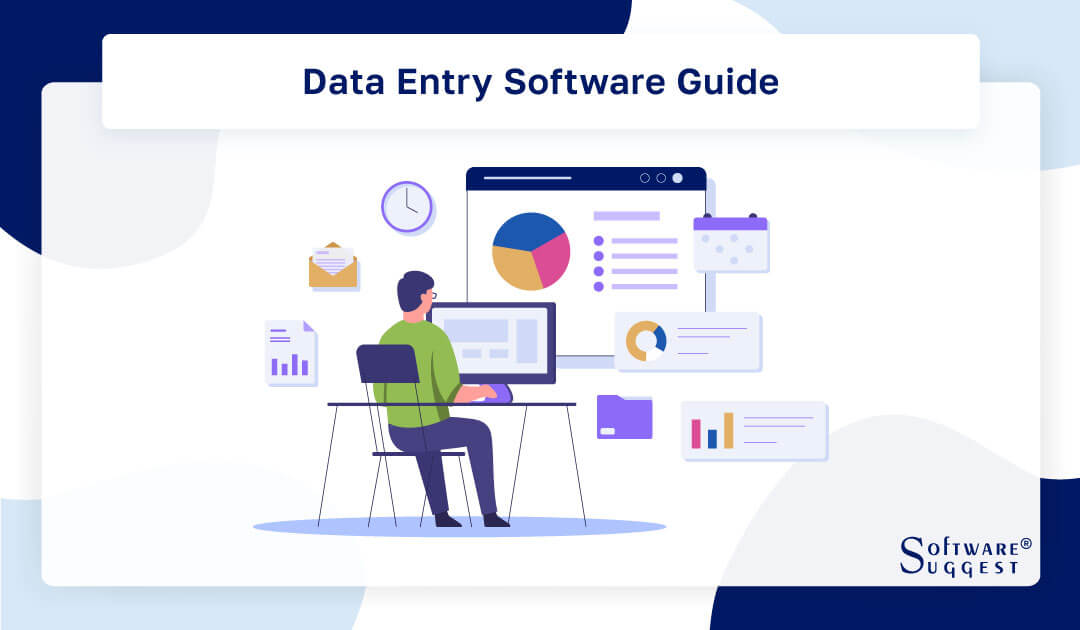
The accurate and efficient management of data lies at the heart of organizational success. Data entry software has emerged as a leader in this process, revolutionizing the way information is collected, organized, and utilized. From simplifying mundane tasks to offering advanced automation, these software solutions have evolved to meet the dynamic needs of modern businesses.
This buyer’s guide explores the features, trends, challenges, and benefits that define data entry software, showcasing its pivotal role in transforming data into actionable insights.
What is Data Entry Software?
Data Entry Software refers to specialized computer programs designed to facilitate the efficient and accurate input of various types of data into digital systems. It streamlines the process of transferring information from physical sources such as paper documents, forms, or spreadsheets into digital formats, databases, or software applications.
This software often features user-friendly interfaces that enable users to manually input data or import it from external sources. With functionalities like auto-formatting, validation checks, and real-time error detection, data entry software programs help minimize inaccuracies and inconsistencies in the entered data.
Advanced data entry software might also include features like automation, where repetitive tasks are performed automatically, improving both speed and accuracy. Overall, data entry software plays a crucial role in enhancing data management workflows, reducing manual effort, and ensuring the integrity of digital information.
How does a Data Entry Software Work?
Data entry software is a type of software that enables you to replace manual data entry processes with various automated software. These types of software help eliminate the use of paperwork and manual spreadsheet entry, which is not only time-consuming but expensive and inefficient as well. Data entry correction software is generally cross-platform and can be used on several devices, including computers, tablets, and smartphones.
Data entry correction software uses Optical Character Recognition Technology. This technology as the name itself suggests, recognizes the characters from the various documents management system that a business provides and then transmits the same into the computer system of the business. It is clear from this that the number of errors can be reduced to a great extent as exactly the same data is transferred into the computer from the documents provided which might get wrongly entered if done manually.
It is software that automates the workflow of transmitting data into the computer. Data entry software gives accuracy in data transmission and almost minimizes human errors. Data management software helps you save massive time and provides a better quality of data. By using data entry point software the data from various documents like bills, forms, etc. gets automatically captured, understood, and transmitted into the computer system.
Types of Data Entry Software
Data entry software encompasses various specialized tools tailored to specific tasks, each offering unique features to enhance accuracy, efficiency, and overall data management. Here, we look into three prominent types of data entry software: Transcription data entry software, data entry accounting software, and Form and Survey data entry software.
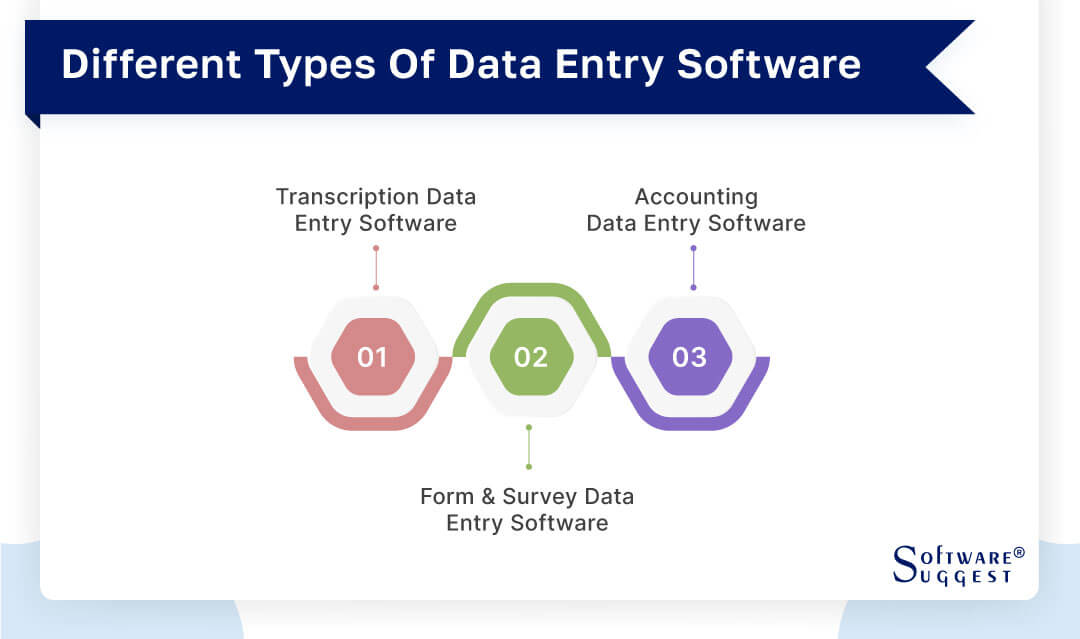
-
Transcription Data Entry Software
Transcription data entry software is designed to convert spoken or recorded language into written text. This type of software is particularly useful for professionals who need to transcribe audio recordings, interviews, meetings, podcasts, and more. It often includes features like playback control, variable speed settings, and automatic time-stamping.
Advanced transcription software might leverage speech recognition technology to automate parts of the transcription process, speeding up the overall workflow. By transforming spoken content into text, transcription data entry software ensures accurate documentation and easy retrieval of information.
-
Accounting Data Entry Software
Accounting data entry software is tailored for financial professionals who need to manage and record financial transactions accurately. This software is essential for maintaining up-to-date records of income, expenses, invoices, and receipts. It often integrates with accounting systems and spreadsheets to streamline data entry, reconciliation, and financial reporting.
Some accounting software also provides features like automated expense categorization, bank reconciliation, and tax calculation. By automating and organizing financial data entry tasks, accounting software helps prevent errors, improve financial transparency, and support informed decision-making.
-
Form and Survey Data Entry Software
Form and survey online data entry software focuses on creating interactive forms, surveys, questionnaires, and feedback forms. This type of software enables users to design engaging and customizable forms that respondents can fill out online.
It often includes features like conditional logic, media integration, and real-time analytics. Form and survey data entry system is widely used for market research, customer feedback collection, employee assessments, and more. The dynamic nature of these forms, coupled with real-time data analysis, enhances data accuracy and provides valuable insights.
Benefits of Data Entry Programs
Data entry programs have emerged as invaluable tools in modern information management, offering a range of advantages that streamline business processes and enhance the quality of recorded data. From improving accuracy to automating manual data entry tasks, these programs play a pivotal role in transforming data-related workflows. Here, we explore the notable benefits of utilizing data entry programs.

-
Increase Accuracy
Data entry programs significantly enhance data accuracy by incorporating validation checks and error correction mechanisms. Automated features within the software help catch inconsistencies, missing information, and formatting errors, ensuring that the entered data is reliable and error-free.
-
Reduces Errors
Manual data entry is prone to human errors, which can lead to misinformation, discrepancies, and costly mistakes. Data entry programs mitigate such risks by minimizing the need for manual intervention, resulting in more precise and consistent data records.
-
Boosts Efficiency and Clarity
Data recording software streamlines the input process through user-friendly interfaces, standardized templates, and automated data transfer. This not only accelerates the data entry process but also ensures uniformity in presentation, making it easier to understand and interpret the information.
-
Faster Turnaround Time
Automated data entry programs expedite the process by eliminating the need to manually input each piece of information. This leads to faster turnaround times, enabling organizations to access and utilize the data more promptly for decision-making.
-
Greater Insight into Your Data
Data entry programs often come with built-in analytics and reporting features that provide valuable insights into trends, patterns, and correlations within the data. This facilitates informed decision-making and strategic planning based on accurate and up-to-date information.
-
Decreases Paperwork and Costs
By transitioning from paper-based data entry to digital systems, data entry programs help reduce paperwork and associated administrative costs. This eco-friendly shift also minimizes the need for physical storage space and enhances data security.
Features of Data Entry Software
Data entry correction software offers a wide range of functionality that can help you improve efficiency and customer satisfaction, as discussed in the earlier section. Although the major and the most widely-used feature of data entry correction software is data capture and transfer, large enterprises use it for Abbreviation Detection and Data Retrieval as well. Let's discuss in brief the features the best data entry software can offer.
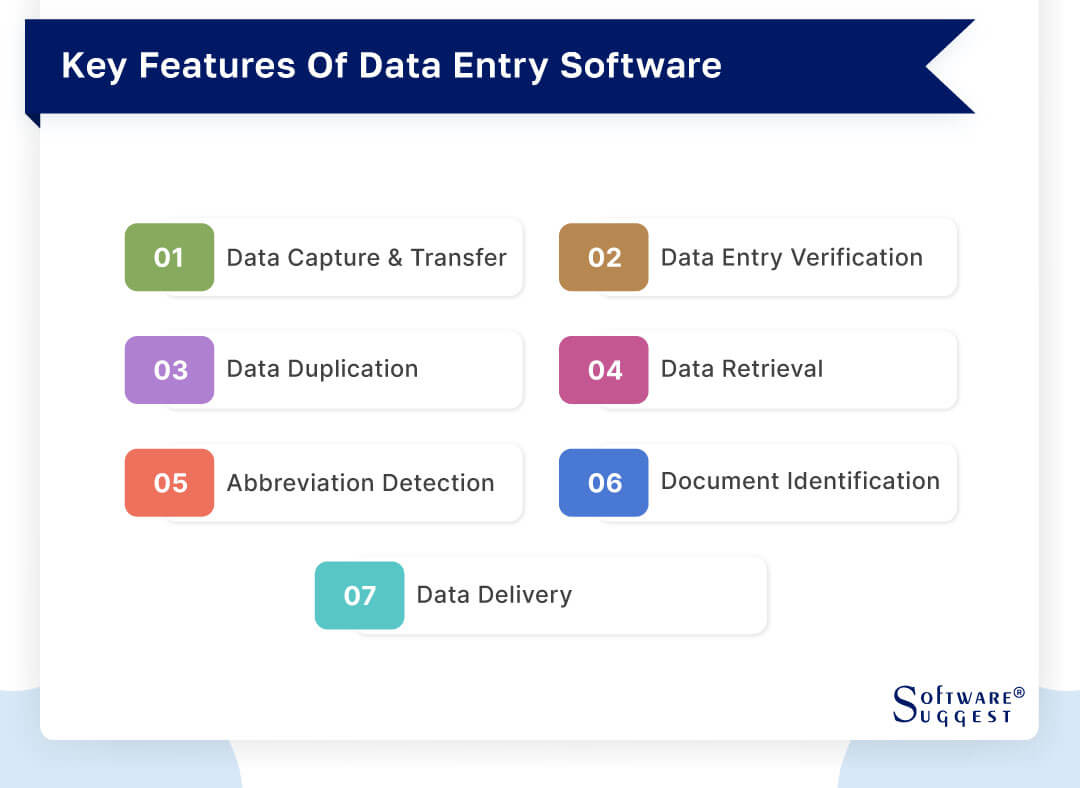
-
Data Capture and Transfer
Automated data entry software allows you to identify and capture data from the database and transfer it for analysis.
-
Data Entry Verification
Best data entry software for PC checks the data for inconsistencies and inaccuracies, making sure the information is accurate.
-
Data Duplication
Duplicate data can accumulate over time in the system, which can eat up storage space and slow down the system. Data entry point software removes the repeated data copies from your system to make sure your database management includes only one instance of data.
-
Data Retrieval
Software for data entry work provides the feature for data recovery as well, in which it extracts the desired data stored in ODBMS.
-
Abbreviation Detection
Abbreviation Detection is a rare feature that a few data entry system software programs offer. This feature includes detecting various abbreviations like DETB, DETC, and DETCOM to display the desired outputs.
-
Document Identification
Data entry system software can identify documents automatically at the acquisition point.
-
Data Delivery
These types of data entry software deliver data and documents to your information and content management systems.
What Should Consider When Purchasing Data Entry Software?
It’s all about the correct evaluation, the better you evaluate, the better you purchase.
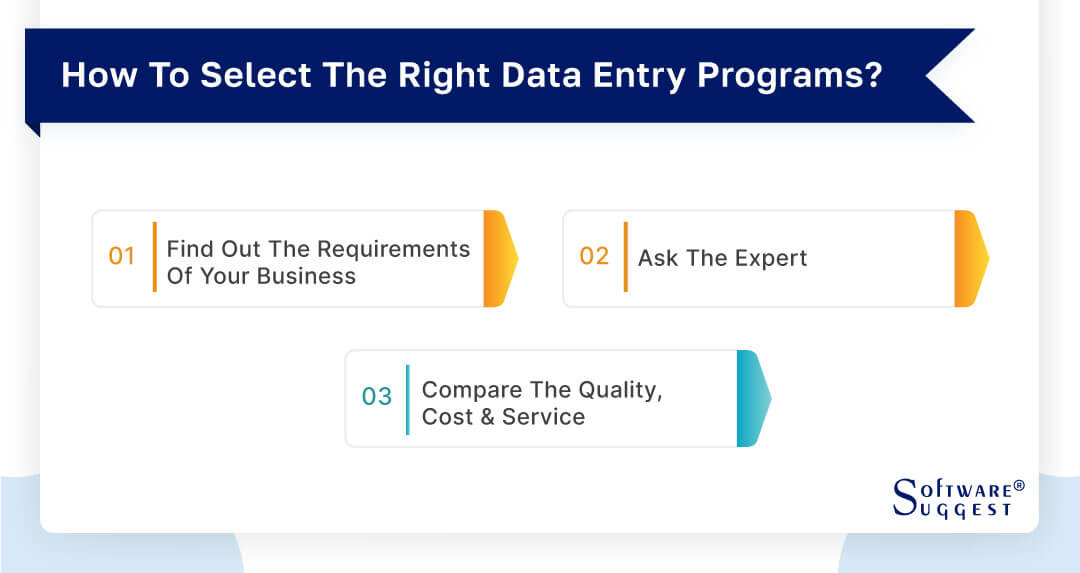
-
Find out the requirements of your business
This should be the first step as it will help you identify the best software for your business. Every prospective user of the data entry point software must be included in the decision-making process so that a mutual agreement can be grasped.
-
Ask the Expert
Share the requirements that you have identified in the initial stage with the Data entry correction software expert or dealer and take his help in deciding which software will match your necessity the finest.
-
Compare the Quality, Cost, and Services
In order to get the best data entry software, it is always better to keep the survey using survey software. Keep taking advice and suggestions from the dealers of data entry point software and compare the quality and the cost and the services the suggested software offers you. Compare it with the business requirements and place the order accordingly.
Top 5 Data Entry Software Comparison
|
Name
|
Free Trial
|
Demo
|
Pricing
|
|---|---|---|---|
|
15 Days |
Yes |
Starting price at $7.01/month | |
|
7 Days |
Yes |
Starting price at $499/model/month |
|
|
14 Days |
Yes |
Starting price at $500/month |
|
|
14 Days |
Yes |
On Request |
|
|
14 Days |
Yes |
On Request |
Data entry software streamlines the process of inputting and managing data, catering to diverse needs across industries. Here, we present a curated list of the top 5 data entry software options that have garnered recognition for their robust features and user-friendly interfaces.
1. Zoho Forms
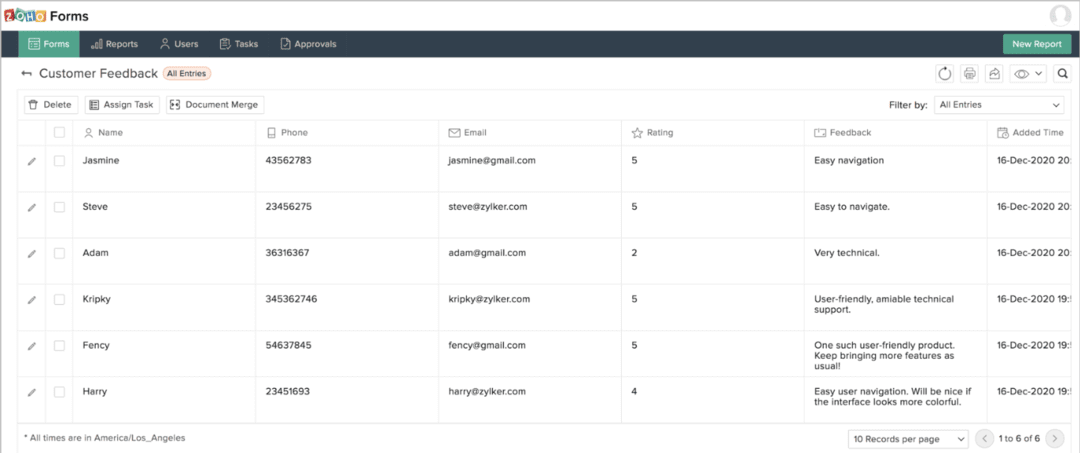
Zoho Forms is a popular data entry software, purpose-built to streamline the collection and management of information. It equips users with the ability to effortlessly fashion personalized online forms and surveys, catering adeptly to a diverse array of data-gathering requirements. Through an instinctive drag-and-drop interface, users can meticulously construct forms aimed at amassing data, viewpoints, or feedback from a myriad of origins.
The innate strength of Zoho Forms lies in its capacity to simplify data entry, made possible by furnishing an assortment of field types – encompassing text, multiple-choice options, file uploads, and more. This comprehensive approach ensures that the amassed data is not only inclusive but also precise. Additionally, the software seamlessly harmonizes with other Zoho applications and external third-party tools, thereby facilitating a seamless flow of data for analytical purposes.
- Drag-and-drop Interface
- Variety of field types
- Automated workflows
- Integration with Zoho and third-party apps
- Data analytics and visualization
- Security and data protection
- Offline forms
- Payment integration
- Notifications and reminders
- Zoho Forms is easy to use and very affordable.
- Zoho is highly customizable.
- Sharing data online is easy using Zoho Forms.
- The survey templates make the tool easy to understand creating quick surveys is easy.
- There should be easier integration between Zoho CRM and Zoho Forms.
- Pre-filled client info or ways to easily import info to forms from Zoho CRM should be there.
Pricing
- Basic: $/7.01/month billed annually
- Standard: $17.53/month billed annually
- Professional: $35.06/month billed annually
- Premium: $70.11/month billed annually
2. Nanonets
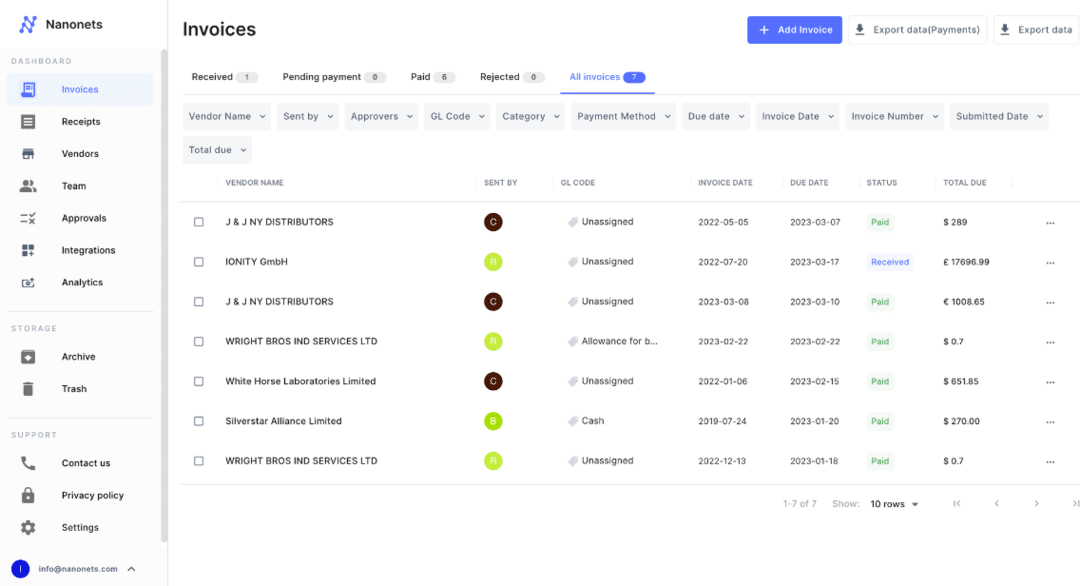
Nanonets is a cutting-edge data feeding software that leverages advanced machine learning and artificial intelligence technologies to automate and streamline the process so the team can extract data and entry seamlessly. With Nanonets, an advanced data entry tool, organizations can drastically reduce manual data entry efforts, errors, and time-consuming tasks. The software specializes in extracting relevant information from a variety of sources, including scanned documents, images, PDFs, and more.
Through its intelligent algorithms, Nanonets can accurately identify and categorize data points, such as text, numbers, and dates, transforming unstructured data into structured formats. Nanonets' user-friendly interface and customization options allow users to train the system to recognize specific data fields unique to their industry or requirements.
- AI-powered data extraction
- Customizable data fields
- Data categorization
- Accuracy improvement
- Flexibility and adaptability
- Data validation and quality control
- Secure data handling
- Reporting and analytics
- Nanonets significantly reduce the need for manual data entry.
- With advanced AI algorithms, Nanonets minimize human errors.
- Users can customize the software to recognize and extract specific data fields relevant to their business needs, ensuring a tailored solution.
- Nanonets can be trained to recognize new data formats or fields, making it adaptable to changing data entry requirements over time.
- Implementing and configuring Nanonets may require some initial learning and understanding of its features, especially for users unfamiliar with AI-powered tools.
- Nanonets' accuracy is heavily reliant on the quality of input data.
- While Nanonets excel at extracting structured data, handling complex data types or unstructured content may require additional manual intervention or preprocessing.
Pricing
- Starter: Pay as you go
- Pro: $499/month/model
- Enterprise: Custom Pricing
3. Docsumo
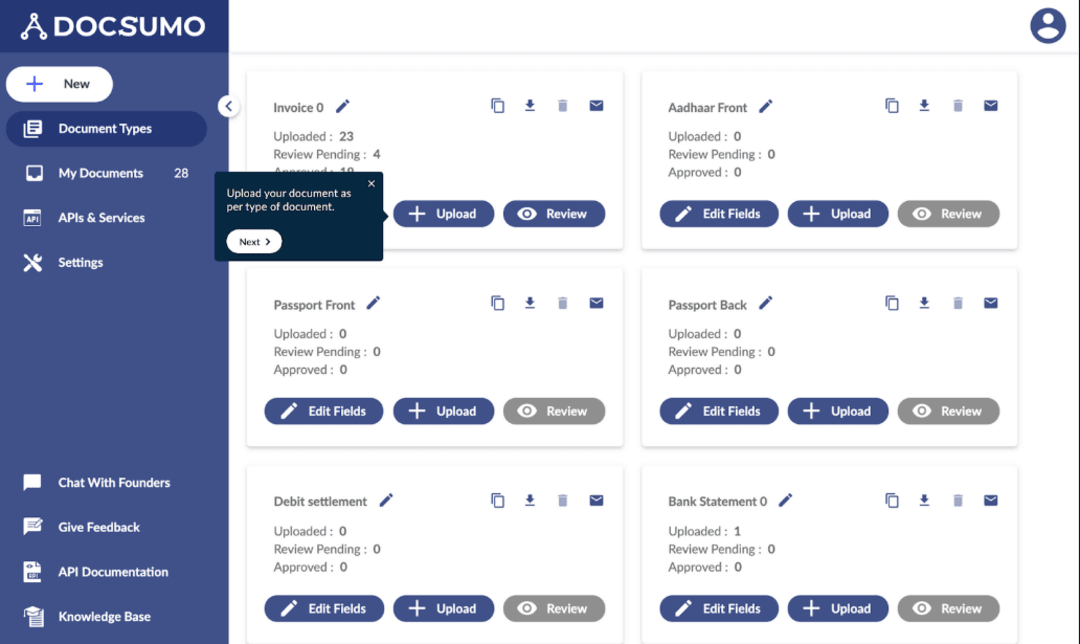
Docsumo is an innovative document processing platform that utilizes advanced artificial intelligence to automate and simplify data extraction from various types of documents. With Docsumo, businesses can efficiently extract critical data such as text, tables, and key information from invoices, receipts, contracts, and other documents.
The software employs cutting-edge machine learning algorithms to swiftly analyze documents, accurately recognizing and extracting relevant data points. This automation significantly reduces the need for manual data entry, saving time and resources while enhancing data accuracy. It enables businesses to process documents at scale, streamline data extraction, and improve overall operational efficiency. By automating the extraction of valuable insights from documents, Docsumo empowers organizations to make informed decisions and drive productivity.
- Automated data extraction
- Document type recognition
- Structured data parsing
- Custom data field mapping
- Validation and accuracy checks
- Integration capabilities
- Data transformation
- Api Access
- Data security
- Docsumo uses advanced AI algorithms to automate the extraction of data from various types of documents, reducing the need for manual data entry and saving time.
- The AI-driven technology enhances data accuracy by minimizing human errors that often occur during manual data entry processes.
- Docsumo is versatile and can handle a wide range of document types.
- Integrating Docsumo with existing systems and workflows may require technical expertise and effort.
- The adoption of advanced AI technology like Docsumo may come with associated costs that need to be evaluated against the benefits gained.
Pricing
- Growth: $500+/month
- Business: Custom Pricing
- Enterprise: Custom Pricing
4. Foxtrot RPA

Foxtrot RPA is the best software for data entry that specializes in automating repetitive tasks through Robotic Process Automation (RPA) technology. Designed to streamline data entry processes, Foxtrot RPA allows organizations to create and implement automation workflows without extensive coding expertise. With Foxtrot RPA, businesses can effortlessly automate data entry tasks, eliminating manual effort and reducing the risk of errors.
The software interacts with various applications and systems, mimicking human actions to input data accurately and efficiently. Foxtrot RPA's adaptability caters to tasks of varying complexities, making it a versatile solution for industries seeking to optimize data management workflows.
- Visual workflow designer
- Data interaction
- Data validation
- Data transformation
- Error handling
- Workflow automation
- Data security
- Task scheduling
- Integration capabilities
- Data accuracy
- Foxtrot RPA automates data entry tasks, significantly reducing manual effort and saving time.
- The software minimizes the risk of human errors, leading to higher data accuracy and reliability.
- Foxtrot RPA streamlines data entry processes, allowing for end-to-end automation and improved efficiency.
- Users can design and customize automation workflows using a visual interface, catering to specific business needs.
- Scaling up to more complex and high-volume tasks requires substantial adjustments to the automation setup.
- Licensing and implementation costs is a concern for smaller businesses or projects with tight budgets.
- Foxtrot RPA can introduce mistakes if not programmed correctly.
Pricing
- On Request
5. Typeform
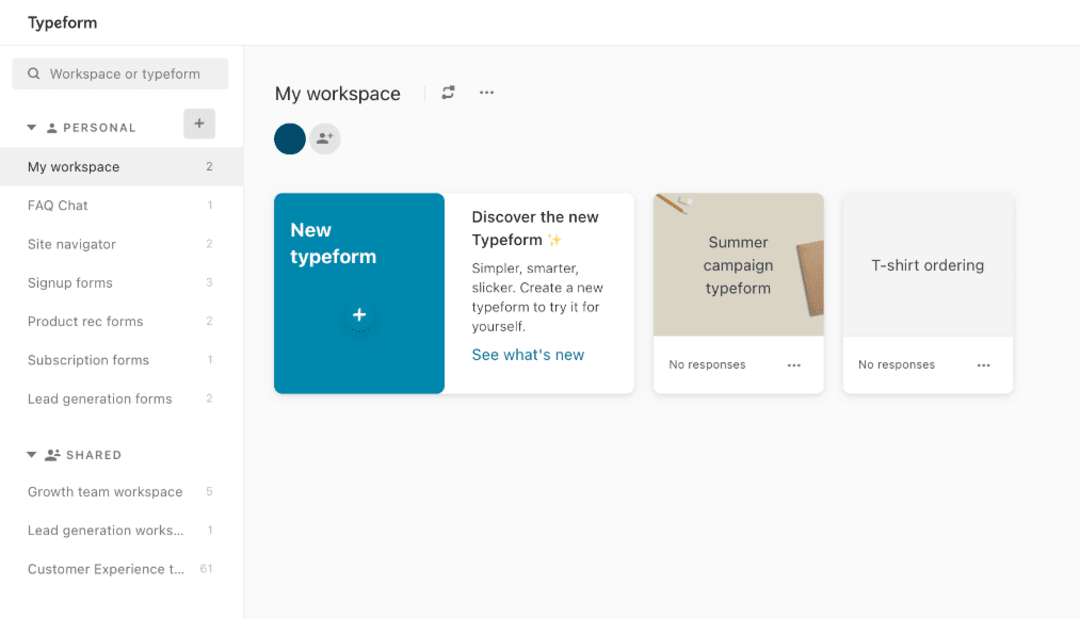
Typeform is a user-friendly automated data entry software that revolutionizes the way information is collected and organized. With its intuitive interface and interactive design, Typeform replaces traditional static forms with dynamic and engaging surveys, quizzes, and questionnaires. It empowers users to create customized forms that adapt to respondents' answers, providing a personalized experience that enhances data accuracy and completion rates.
Typeform's visually appealing layouts and seamless integration options make data entry a more enjoyable process for both creators and respondents, while its robust analytics tools offer valuable insights for informed decision-making. Whether for gathering customer feedback, conducting market research, or running internal assessments, Typeform simplifies data entry and transforms it into a dynamic and insightful interaction.
- Interactive form design
- Customization options
- Conditional logic
- Seamless integrations
- Multi-device compatibility
- Collaboration tools
- Payment collection
- Offline response collection
- Survey logic and skip logic
- It is super easy to use and creates beautiful forms.
- The UI/UX of the software is great.
- Simple drag, drop, and create feature if a great option.
- The calculator tool allows you to use numerical formulas to create logic within your form for specific behavior.
- The software should have better summary reports.
- Design schemes and template choices should have more options.
- The branching can be difficult to understand at the start.
Pricing
- On Request
Latest Ways to Make Data Entry Faster
Data entry software is easy to use, but knowing some tips and tricks can help you make your data entry faster and more efficient. These data entry tips are listed below.
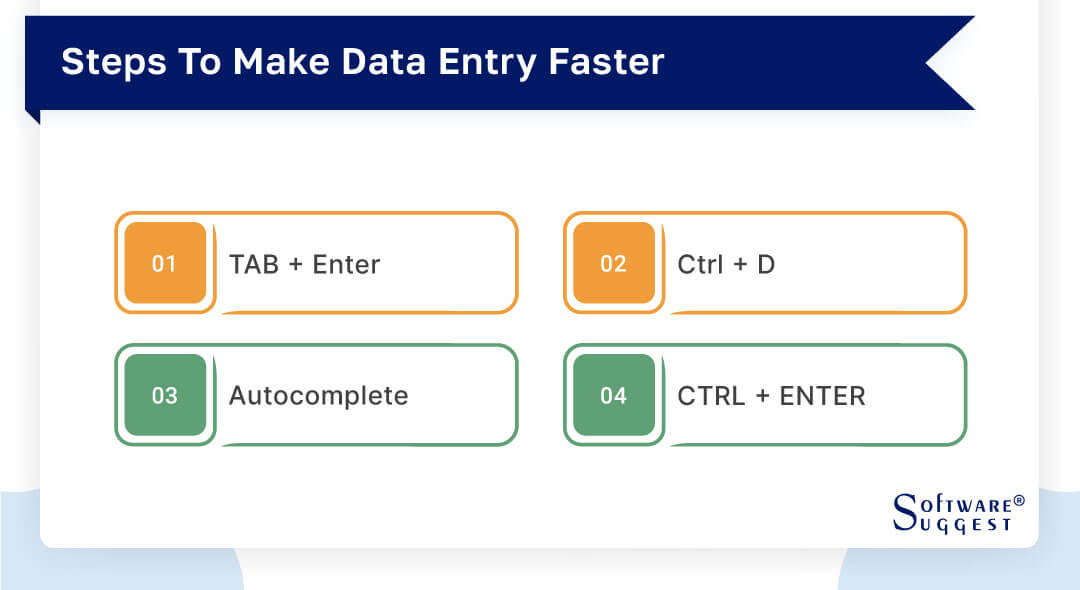
-
TAB + Enter
One of the most time-consuming things to do in Excel is to click on a cell every time you want to enter data. Although many people know this trick, a few people don't, and if you are one of them, this tip can help you a lot with speeding up your data entry. The tip is simple; all you need to do is to press TAB + Enter on a cell to start writing. This way, you will eliminate the need for using the mouse during your data entry work.
-
Ctrl + D
If you want to copy the data from one cell to another cell right below it, you can simply press Ctrl + D to copy. Whatever data is present in the above cell will be copy-pasted in the below cell, and whatever text was written in the below cell will be overwritten. You can also select multiple cells before pressing Ctrl + D.
-
Autocomplete
Most of you must have noticed this feature in excel, but not a lot of people know how to use it the right way. If you have written a word, say "Name" is one of the cells in your Excel doc. Now, when you type 'N' in another cell, the word name will automatically prompt.
However, most beginners end up writing the entire word over it. Instead of doing so, what you can do is when the highlighted word prompts up, you can press TAB to select the word and move to the right cell, or press 'Enter' to move to the below cell. If you don't want to write what is suggested, you can press 'Backspace' to discard the suggestion.
-
CTRL + ENTER
If you want to add similar data in a few numbers of cells, you can do it in a quicker way than pasting the value in every cell. To enter a value in all a few cells, you need to copy the data and press CTRL + ENTER to enter the same data in all the selected cells.
Top Challenges in Data Entry Programs
While data entry programs offer a range of benefits for streamlining information management, they are not without their challenges. These challenges can impact the efficiency, accuracy, and overall effectiveness of data entry processes. In this discussion, we delve into three significant challenges that organizations often encounter when utilizing data entry programs: Data Volume, Data Configuration, and System Downtime.
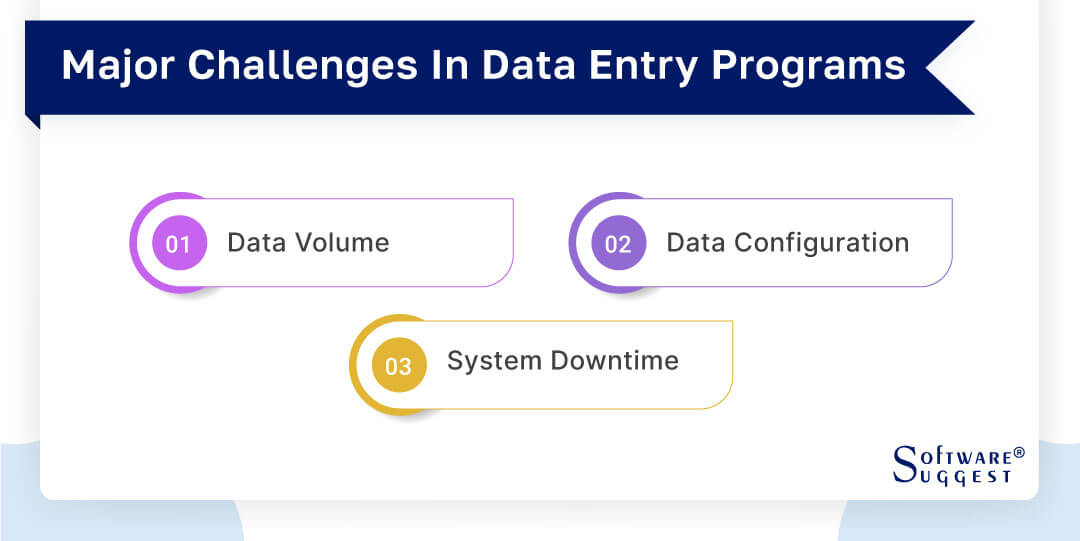
-
Data Volume
One of the primary challenges in data entry programs is handling large volumes of data. As organizations collect and accumulate vast amounts of information, data entry processes can become overwhelming.
Manual data entry for extensive datasets can be time-consuming and error-prone, potentially leading to inaccuracies and inconsistencies. Automated data entry can help mitigate this challenge, but it requires careful design and validation to ensure data accuracy while managing high volumes of information.
-
Data Configuration
Different data sources often have varying structures, formats, and layouts. This diversity can pose challenges in data configuration, as data entry programs need to accommodate and normalize data from different origins. Ensuring seamless integration and accurate mapping of data fields can be complex, especially when dealing with multiple data formats or when integrating data from various sources. Data transformation and validation mechanisms are crucial to maintain data integrity during this process.
-
System Downtime
Data entry programs heavily rely on software systems and digital platforms. System downtime due to maintenance, updates, or technical glitches can disrupt data entry workflows. In such instances, organizations might face delays, data loss, or errors that can impact operations. Mitigating system downtime requires careful planning for system updates and ensuring data backup and recovery mechanisms are in place to minimize disruptions and data loss.
Advanced Tips and Tricks for Data Entry
Data entry software can be time-consuming if you don't get proficient in using them. The best data entry system software offers seamless functionality but comes with some complicated controls and interfaces that can confuse a beginner.
These tips will help you work smoothly on automated data entry software.
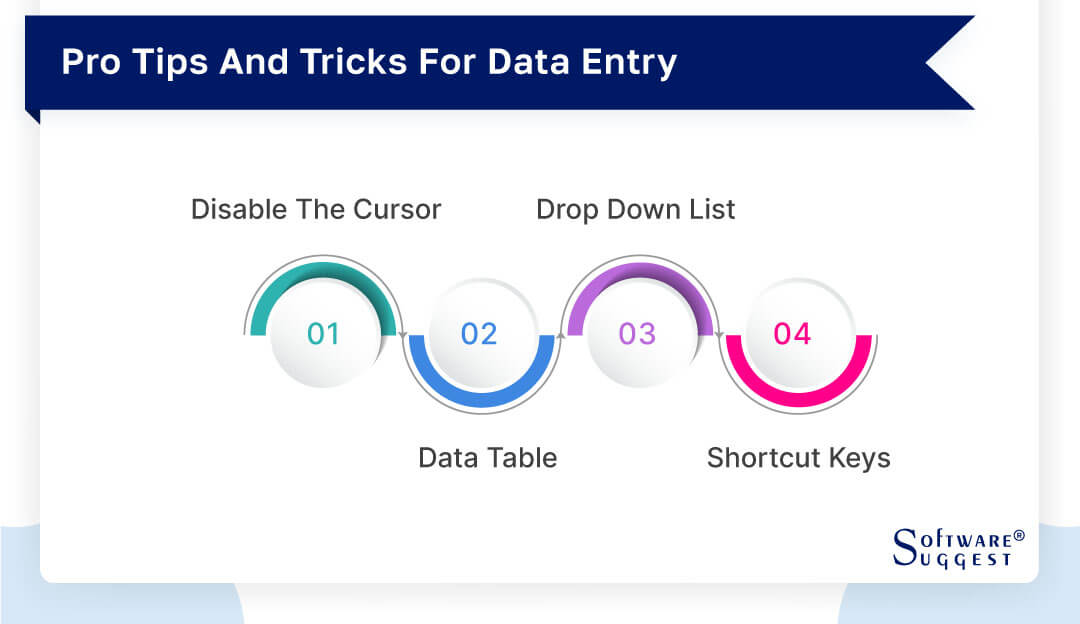
1. Disable the Cursor
Online data entry software includes a cursor that takes a position in the data entry interface. This person is not only distractive but becomes a hurdle and stops you from smoothly navigating through your data entry software. However, you can disable the cursor by changing the "Editing Option" feature in the advanced settings header. After disabling this feature, you can use your keyboard and arrow keys to navigate and move the cursor all over the software interface.
2. Data Table
In data entry software for PC, you can utilize data tables to boost your data entry efficiency significantly. When you click on "Table" in the standard toolbar, it upgrades your overall data entry process by providing several sort options and filters.
3. Drop Down List
In the best data entry software for business, you can create your drop-down list to make your data more consistent and organized. All you need to do is create a range of items you need in a drop-down list. Then, click on "Data" in the standard toolbar, and then click on "Data Tools" > "Data Validation." From there, you can click on settings, then allow, and then check the ‘In-Cell Drop Down’ option.
4. Shortcut Keys
A data entry task management system can be simplified and carried out more efficiently if you use shortcut keys. Some useful shortcut keys that can help you with your data entry tasks are:
- Tab key for moving the cursor to the next cell
- Alt+Tab to switch between opened windows
- Shift+Tab to return to the previous cell
- Ctrl+A to select the entire page
- Ctrl+C to copy the selected data
- Ctrl+V to create the copy of the data copied
- Ctrl+Z to undo the last action
- Ctrl+Shift+Z to reverse the last undo action
Latest Market Trends in Data Entry Software
As technology continues to evolve, so does the landscape of data entry software. Modern innovations are reshaping the way data is collected, processed, and managed, offering new opportunities to enhance efficiency, accuracy, and user experience. In this exploration, we delve into five latest trends that are shaping the future of data entry software.
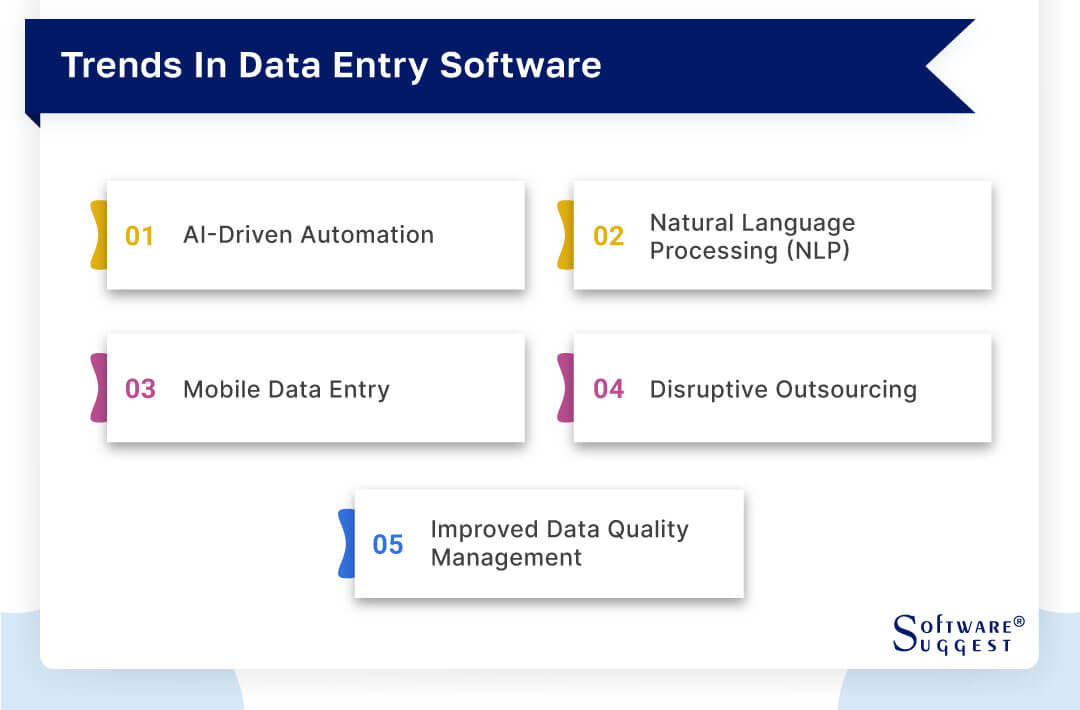
-
AI-driven Automation
Artificial Intelligence (AI) has revolutionized data entry by introducing automation that goes beyond traditional rule-based processes. AI-driven data entry software employs machine learning algorithms to recognize patterns in unstructured data, making it possible to automate the extraction and input of information from various sources. This trend reduces manual effort and enhances accuracy and speed, resulting in streamlined data entry workflows.
-
Natural Language Processing (NLP)
Natural Language Processing (NLP) enables data entry software to understand and interpret human language, facilitating more intuitive interactions. With NLP, users can input data using natural language, eliminating the need for rigid form-based entry. This trend is especially prominent in chatbots and voice recognition systems, allowing users to engage in data entry conversations that feel more conversational and user-friendly.
-
Mobile Data Entry
Mobile devices have become ubiquitous, prompting data entry software to adapt to this trend. Mobile data entry solutions allow users to input information using smartphones and tablets, enabling on-the-go data collection. These apps often come with features like image capture, location tagging, and offline functionality, making data entry more convenient and accessible.
-
Disruptive Outsourcing
Outsourcing data entry tasks to specialized service providers is not new, but disruptive outsourcing takes it a step further. Cloud-based platforms connect businesses with a global network of data entry freelancers, creating a decentralized and efficient workforce. This trend offers scalability, cost-effectiveness, and access to diverse skill sets while challenging traditional outsourcing models.
-
Improved Data Quality Management
Ensuring data accuracy and quality is a perennial concern in data entry. The latest trend in data entry software involves integrated data quality management features. These features include real-time validation, de-duplication, and data enrichment tools that enhance data accuracy right at the point of entry, reducing the need for later corrections and improving overall data integrity.
Conclusion
Data entry software stands as a technological ally that bridges the gap between information and meaningful action. Its ability to streamline and enhance the data entry process not only saves time and resources but also elevates the quality of collected information. As technology continues to advance, data entry software adapts, embracing innovations like AI-driven automation, mobile compatibility, and improved data quality management.
Organizations that embrace these tools are poised to unlock a future where data entry is not merely a task but a strategic enabler of growth and innovation. In the ever-evolving landscape of data management, data entry software remains an essential cornerstone, paving the way for informed decision-making and efficient workflows.
FAQs
The process of entering data from one data format into another, more viable and usable data format is called data entry.
Yes, data entry system software increases employee efficiency and customer satisfaction, which in turn improves your business performance.
The cost of data entry software varies widely based on factors such as the software's features, capabilities, scalability, and the vendor's pricing model. Basic data entry software with fundamental features can often be found as free or low-cost options, while more advanced and specialized solutions with automation, integration, and enhanced data security features can range from monthly subscriptions in the tens to hundreds of dollars, or even custom pricing for enterprise-level solutions. It's important to carefully evaluate the software's fit with your organization's needs and budget before making a decision.
Data entry software accommodates a wide array of information types, offering the flexibility to capture diverse forms of data accurately and efficiently. This encompasses both structured and unstructured data. Users can input alphanumeric data, including text, numbers, dates, and codes, into designated fields. Moreover, data entry software can handle categorical data, such as selecting options from dropdown menus, checkboxes, or radio buttons. Additionally, it's capable of processing numerical data for quantitative analysis, as well as handling text-based data for qualitative insights. The software is often equipped to manage media-rich content like images and videos, enabling multimedia data input.
Data entry software often comes with the capability to integrate seamlessly with a variety of other software applications, enhancing overall data management and workflow efficiency. Common integrations include Customer Relationship Management (CRM) systems like Salesforce, marketing automation tools like HubSpot, and project management platforms such as Trello or Asana. Accounting software like QuickBooks can also integrate to streamline financial data entry processes.
Furthermore, data entry software often connects with spreadsheet applications like Microsoft Excel or Google Sheets, facilitating data import and export. Many data entry solutions also provide API (Application Programming Interface) access, enabling custom integrations with proprietary or industry-specific software. These integrations contribute to data consistency, real-time synchronization, and improved data utilization across various systems, fostering a cohesive and productive digital environment.
Data entry in Excel refers to the process of inputting, organizing, and managing various types of information within a Microsoft Excel spreadsheet. This involves populating cells with text, numbers, dates, and other data, often within rows and columns. Excel provides a user-friendly interface for manual data input, and it offers features like auto-fill, formula calculations, and data validation to enhance accuracy and efficiency. Data entry in Excel is commonly used for tasks such as creating lists, tracking expenses, managing inventory, and performing basic data analysis. The structured layout of Excel spreadsheets makes it a versatile tool for organizing and manipulating data for various purposes.
By Industries


_(1).png)



















